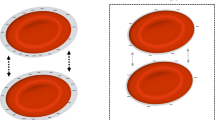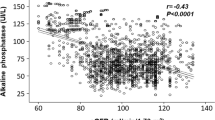Abstract
Non-modulating is a highly reproducible type of sodium-sensitive hypertension. The aim of this study was to evaluate in non-modulating individuals the erythrocyte sodium-lithium countertransport (SLC) abnormalities, which have been mentioned as a marker of non-modulation, and the association with increased microalbuminuria, as a marker of an early kidney impairment. We measured erythrocyte SLC in 10 normotensives (NT, 28 ± 4 years), 20 offspring of hypertensive parents being 10 modulating (MHO, 25 ± 6 years) and 10 non-modulating (NMHO, 26 ± 5 years), and 23 essential hypertensives being 12 modulating (MHT, 34 ± 5 years) and 11 non-modulating (NMHT, 32 ± 4 years). In all the subjects studied, microalbuminuria was determined by duplicate 24-h urine collection by radioimmunoassay. In non-modulating offspring of hypertensive parents and essential hypertensives. SLC was significantly elevated when compared either with normotensives without family history of hypertension, modulating offspring of hypertensive parents or essential hypertensives (P < 0.025). Likewise, 24-h urinary albumin excretion was found higher in non-modulating individuals (essential hypertensives and offspring of hypertensive parents) than in modulating individuals (P < 0.01). In conclusion, non-modulators with higher SLC countertransport sodium transport abnormalities showed higher elimination of microalbuminuria suggesting that non-modulators may have an increased risk for developing cardiovascular morbidity and kidney impairment even in normotensive subjects with familiarity history of hypertension.
This is a preview of subscription content, access via your institution
Access options
Subscribe to this journal
Receive 12 digital issues and online access to articles
$119.00 per year
only $9.92 per issue
Buy this article
- Purchase on Springer Link
- Instant access to full article PDF
Prices may be subject to local taxes which are calculated during checkout
Similar content being viewed by others
References
Dahl LH . Salt and Hypertension Am J Clin Nutr 1992 25: 231–244
Mac Gregor GA . Sodium is more important than calcium in essential hypertension Hypertension 1985 7: 628–637
Weinberger NH . Salt sensitivity as a predictor of hypertension Am J Hypertens 1991 4: 615s–616s
Williams GH, Hollenberg NK . Non-modulating hypertension: a subset of sodium sensitive hypertension Hypertension 1991 17 (Suppl 1): 1–81–1–85
Sánchez RA et al. Erythrocyte sodium-lithium countertransport in non-modulating offspring and essential hypertensive individuals Hypertension 1997 30: 99–105
Ramrez AJ et al. Renal sodium handling abnormalities in hypertensives and normotensivepatients with a family history of hypertension J Hypertens 1989 7 (Suppl 7): S19–S20
Redgrave J et al. Red blood cell lithium countertransport in non-modulating essential hypertension Hypertension 1989 13: 721–726
Kahn AM, Allen JC, Cragoe EG jr . Shelat H. Sodium-lithium exchange and sodium-proton exchange are mediated by the same transport system in sarcolemmal vesicles from bovine superior mesenteric artery Circ Res 1989 65: 818–828
Canessa ML . Morgan K, Semplicini A. Genetic differences in lithium sodium exchange and regulation of the sodium-hydrogen exchanger in essential hypertension J Cardiovasc Pharmacol 1988 12: S92–S98
Weder AB . Red cell lithium-sodium countertransport and renal lithium clearence in hypertension N Engl J Med 1987 314: 198–201
Doria A et al. Insulin resistance is associated with high sodium-lithium countertransport in essential hypertension Am J Physiol 1991 261: E684–691
Ruilope LM . The kidney as part of the cardiovascular system J Cardiovsc Pharmacol 1999 3 (Suppl 1): S7–S10
Bigazzi R et al. Microlbuminuria in salt-sensitivepatients. A marker for renal and cardiovascular risk factors Hypertension 1994 23: 195–199
Schnurr E, Lahma W, Kuppers H . Measurements of renal clearence of inulin and PAH in the steady-state without urine collection Clin Nephrol 1980 13: 26–29
Canessa M et al. Increased sodium-lithium countertransport in red cells ofpatients with essential hypertension N Engl J Med 1980 302: 772–776
Sánchez RA et al. Actividad reninica plasmatica en la hipertension esencial Medicina (BsAs) 1979 39: 171–179
Ramirez AJ et al. Microalbuminuria in borderline and established hypertension: effects of the antihypertensive treatment High Blood Press 1995 4: 160–166
Hopkins PN et al. Blunted renal vascular response to angiotensin it is associated with a common variant of the angiotensinogen and obesity J Hypertens 1996 14: 199–207
Schmid Ch et al. Dietary salt intake modulates angiotensin II type I receptor gene expression Hypertension 1997 29: 923–929
Gordon MS, Gordon MB, Hollenberg NK, Williams GH . Non-modulating trait may precede the development of hypertension Am J Hypertens 1994 7: 789–793
Geleijinse JM et al. Long-term effects of neonatal sodium restriction on blood pressure Hypertension 1996 29: 913–917
Lluch M et al. Erythrocyte sodium transport, intraplatelet pH, and calcium concentration in salt-sensitive hypertension Hypertension 1996 27: 919–925
Canessa M, Redgrave J, Laski C, Williams GH . Does sodium intake modify red cell Na+ transporter in normal and hypertensive subjects? Am J Hypertens 1989 2: 515–523
Weder AB . Membrane sodium transport and salt-sensitivity of blood pressure Hypertension 1991 17 (Suppl I): 174–180
Luft FC, Agrawal B . Microalbuminuria as a predictive factor for cardiovascular events J Cardiavasc Pharmacol 1999 33 (Suppl II): S11–S15
Nilsson T et al. The relation of microalbuminuria to ambulatory blood pressure and myocardial wall thickness in a population J Intern Med 1998 244: 55–59
Ferrannini E, Buzzigoli RD, Giorico MA . Insulin resistance in essential hypertension N Engl J Med 1987 317: 350–357
Baldoncini R et al. Elevated albumin excretion in nonmodulating essential hypertensivepatients Nephron 1997 76: 264–269
Author information
Authors and Affiliations
Corresponding author
Rights and permissions
About this article
Cite this article
Sánchez, R., Giannone, C., Masnatta, L. et al. Higher urinary albumin excretion is associated with abnormal erythrocyte Na+/Li+ countertransport (SLC) in non-modulating essential hypertensives and offspring of hypertensive parents. J Hum Hypertens 16 (Suppl 1), S128–S132 (2002). https://doi.org/10.1038/sj.jhh.1001358
Published:
Issue Date:
DOI: https://doi.org/10.1038/sj.jhh.1001358
Keywords
This article is cited by
-
Nonmodulation and essential hypertension
Current Hypertension Reports (2006)



